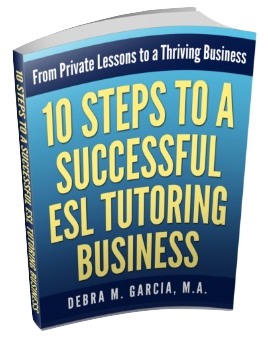Present Progressive Conjugation,
Form, and Function
How to Teach the Present Progressive
Tense to English Language Learners
Present Progressive conjugation is only the first step in teaching this verb tense to students studying English as a second language.
In addition to "conjugation," verb lesson plans must also include "form" and "function" of the tense being taught.
The Present Progressive tense (also called Present Continuous) is usually one of the first verb tenses ESL students are taught. However, prior to a grammar lesson teaching this tense, ESL students have to first learn the irregular verb, "to be."
First Step in Present Progressive Conjugation
The verb "to be" is the helping verb (or auxiliary verb) used to form the Present Continuous.
This verb tense is formed by combining the helping verb "to be" with the "-ing" (or the Present Participle) form of the main verb.
- subject + am/are/is + -ing
For example, "She is dancing" ("dancing" is the main verb, "is" is the helping verb).
The Present Participle (-ing) of the main verb will always be the same in the Present Progressive verb tense, no matter who or what the subject is. The helping verb will change according to the subject. (See the examples below.)
Remember, for all verb tenses, three things are essential in teaching English Language Learners:
- Conjugation,
- Form, and
- Function.
Present Progressive conjugation, form, and function are further discussed below.
Present Progressive Conjugation of Verbs
All verbs must be conjugated for the subject pronouns, I, You, She/He/It, They, and We. Here are some Present Continuous Conjugation examples using miscellaneous verbs.
- I am talking. I am reading. I am dancing. I am thinking.
- You are talking. You are reading. You are dancing. You are thinking.
- She/He/It is talking. She/He/It is reading. She/He/It is dancing. She/He/It is thinking.
- They are talking. They are reading. They are dancing. They are thinking.
- We are talking. We are reading. We are dancing. We are thinking.
Present Progressive Verb Forms (five forms ESL/EFL students must learn)
- Affirmative Usage (I am studying. You are studying. She/He/It is studying. They are studying. We are studying.)
- Negative Usage (I am not playing. You are not playing. She/He/It is not playing. They are not playing. We are not playing.)
- Yes/No Questions (Am I reading? Are you reading? Is she/he/it reading? Are they reading? Are we reading?)
- Short Answers (Yes, I am. No, I am not. Yes, you are. No, you are not. Yes, she/he/it is. No, she/he/it is not. Yes, they are. No, they are not. Yes, we are. No, we are not.)
- WH- Questions (e.g., When is she talking? Why are you talking? Where are they studying? Who are they meeting? How are they sleeping? What am I eating?)
Functions of the Present Progressive Tense (when to use the Present Progressive)
The Present Progressive/Present Continuous verb tense has two primary functions, and one secondary function:
- To express an activity that is in progress at the moment of speaking. The activity is temporary. It began in the past, is happening right now, and will probably end at some time in the future (e.g., I am writing an article for my website. She is sleeping on the couch. They are watching television.), and
- To talk about something that is happening generally at this time (during this week, this year, at this time in one's life, etc.), (e.g., I am teaching ESL to adults. She is traveling with friends. He is writing a grammar book. The teacher is preparing a lesson.).
- Using the Present Progressive for the Future: Depending on the context, the Present Progressive can also be used with a future meaning. For example, "Tonight, I'm cooking dinner for friends."
ESL Student Challenges
There are two common challenges ESL students have with Present Progressive conjugation:
- Using the correct auxiliary verb (beginning ESL students often confuse "to do" with "to be"), and
- Knowing when to use the Present Progressive instead of the Simple Present and vice versa.
Related Article
For a thorough discussion on teaching verbs to adults studying ESL or EFL, see my ESL Verb Tenses page.
Additional ESL Resource
Azar's, Understanding and Using English Grammar is an excellent textbook for teaching Present Progressive conjugation, form, and function, as well as all other verb tenses. I use it regularly with my intermediate and advanced ESL/EFL students. It
From Present Progressive Conjugation to Teaching ESL to Adults


New! Comments
Have your say about what you just read! Leave me a comment in the box below.